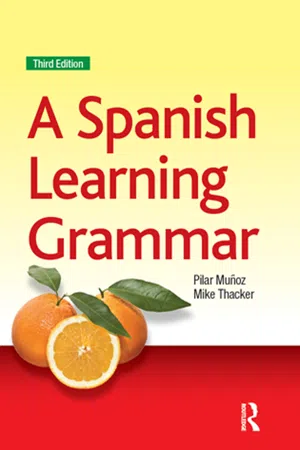1
Pronunciation, accents, spelling and punctuation
1.1 The Spanish alphabet
| Symbol | | Symbol | | Symbol | |
| a | a | j | jota | r | erre |
| b | be | k | ka | s | ese |
| c | ce | l | ele | t | te |
| d | de | m | eme | u | u |
| e | e | n | ene | v | uve |
| f | efe | ñ | eñe | w | uve doble |
| g | ge | o | o | x | equis |
| h | hache | p | pe | y | i griega/ye |
| i | i | q | cu | z | zeta |
Note: Letters of the alphabet (las letras del abecedario) are feminine:
ñ
In Spanish ñ is a separate letter of the alphabet. In dictionaries niñez comes after ninguno.
k and w
Very few words contain k and w. Most of them are imported from other languages, e.g. karate, whisky.
1.2 Pronunciation
Consonants
Some consonants are pronounced in a markedly different way from their equivalent in English. The most important of these differences are as follows:
| b and v have the same sound: |
buenobarbavinovarios
aBefore a, o and u: c is a hard sound (as in ‘come’):
campoarrancacostebancoCubacuando
bBefore e and i: c is a soft sound
In Castilian Spanish (spoken mainly in the north and the centre of Spain) this sound is like English ‘th’ in ‘thin’. In much of Spain and Spanish America the sound is ‘s’:
cenaacentocineincidente
aBefore a, o and u: g is a hard sound (as in ‘go’):
garajeganargordogolgustogusano
bBefore e or i: g is a sound made in the throat, like ch in Scottish ‘loch’:
gentegerentegirogitanodirige
cgu followed by a is pronounced ‘gw’ (as in ‘Gwen’):
guapoaguaguardar
dgu followed by e or i is a hard sound (as in ‘go’); u is silent:
guerralleguéguitarraMiguel
eIn the combinations güe and güi a diaeresis is placed over the u. This indicates that the sound is ‘gw’ (as in ‘Gwen’):
averigüévergüenzaargüir
h is always silent: hombre is pronounced ‘ombre’, hotel ‘otel’, etc.:
j is a sound made in the throat, like ch in Scottish ‘loch’:
hijojardínJorgepajaMéjico
ll is pronounced like lli in ‘pillion’:
llavecallellegarhallar
aA single r at the beginning of a word is normally ‘trilled’ or ‘rolled’, e.g. the r in el río. Otherwise it is a single trill or ‘flap’, as in cara.
br r, as in burro, sierra, is not considered to be a separate letter. It cannot be split to form part of two different syllables. It is always a rolled sound, like a ‘Scottish’ r. The difference between these two sounds can be heard clearly when comparing pero (but) and perro (dog).
x is pronounced
abetween vowels: can be either ‘ks’ (as in ‘expect’) or ‘gs’ (as in ‘example’):
elixirexistiréxito
or
bbefore a consonant: ‘ks’ or, more usually, ‘s’:
exceptoexclamarexperiencia
In Castilian Spanish (spoken mainly in the north and centre of Spain) this sound is pronounced like ‘th’ in ‘thin’. In much of Spain and Spanish America the sound is ‘s’:
zona zigzag zozobra
Vowels
The five vowels are a, e, i, o and u. Wherever a vowel appears in a word it has the same sound value, unlike in English, where the sa...









